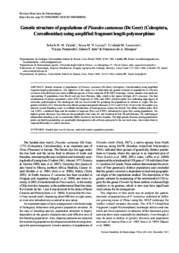Genetic structure of populations of Pissodes castaneus (De Geer) (Coleoptera, Curculionidae) using amplified fragment length polymorphism.
Genetic structure of populations of Pissodes castaneus (De Geer) (Coleoptera, Curculionidae) using amplified fragment length polymorphism.
Autoria: ZALESKI, S. R. M.; LAZZARI, S. M. N.; LAZZAROTTO, C. M.; PANZAVOLTA, T.; IEDE, E. T.; MARQUES, F. de A.
Resumo: Genetic structure of populations of Pissodes castaneus (De Geer) (Coleoptera, Curculionidae) using amplified fragment length polymorphism . The objective of this study was to determine the genetic structure of populations of Pissodes castaneus from different areas and on different species of Pinus using the PCR-AFLP technique. Twenty samples were analyzed, representing 19 populations from Brazil and one from Florence, Italy, which is the region of origin of P. castaneus . The four combinations of primers generated a total of 367 fragments of DNA, and 100% of polymorphic loci, indicating high degree of molecular polymorphism. The dendrogram did not reveal trends for grouping the populations in relation to origin. The low genetic similarity (0.11 between the most distant groups) and genetic distances of 0.13 and 0.44 for 10 out of the 20 samples m ay indicate several founding events or multiple introductions of heterogeneous strains into Brazil. The allelic fixation index (Fs t) was 0.3851, considered high, and the number of migrants (Nm) was 0.3991, indicating low gene flow among populations. The highest genetic distances were between the population from Irani, SC and Cambará do Sul, RS and Bituruna, PR, indicating an independent founding event or a particular allelic fixation in the former location. The high genetic diversity among population s points out that the populations are genetically heterogeneous with a diverse gene pool in the surveyed areas, what makes them t o respond differently to control measures
Ano de publicação: 2013
Tipo de publicação: Artigo de periódico
Unidade: Embrapa Florestas
Observações
1 - Por padrão são exibidas publicações dos últimos 20 anos. Para encontrar publicações mais antigas, configure o filtro ano de publicação, colocando o ano a partir do qual você deseja encontrar publicações. O filtro está na coluna da esquerda na busca acima.
2 - Para ler algumas publicações da Embrapa (apenas as que estão em formato ePub), é necessário ter, no celular ou computador, um desses softwares gratuitos. Sistemas Android: Google Play Livros; IOS: iBooks; Windows e Linux: software Calibre.
Acesse outras publicações
Acesse a Base de Dados da Pesquisa Agropecuária (BDPA) para consultar o acervo completo das bibliotecas da Embrapa.

